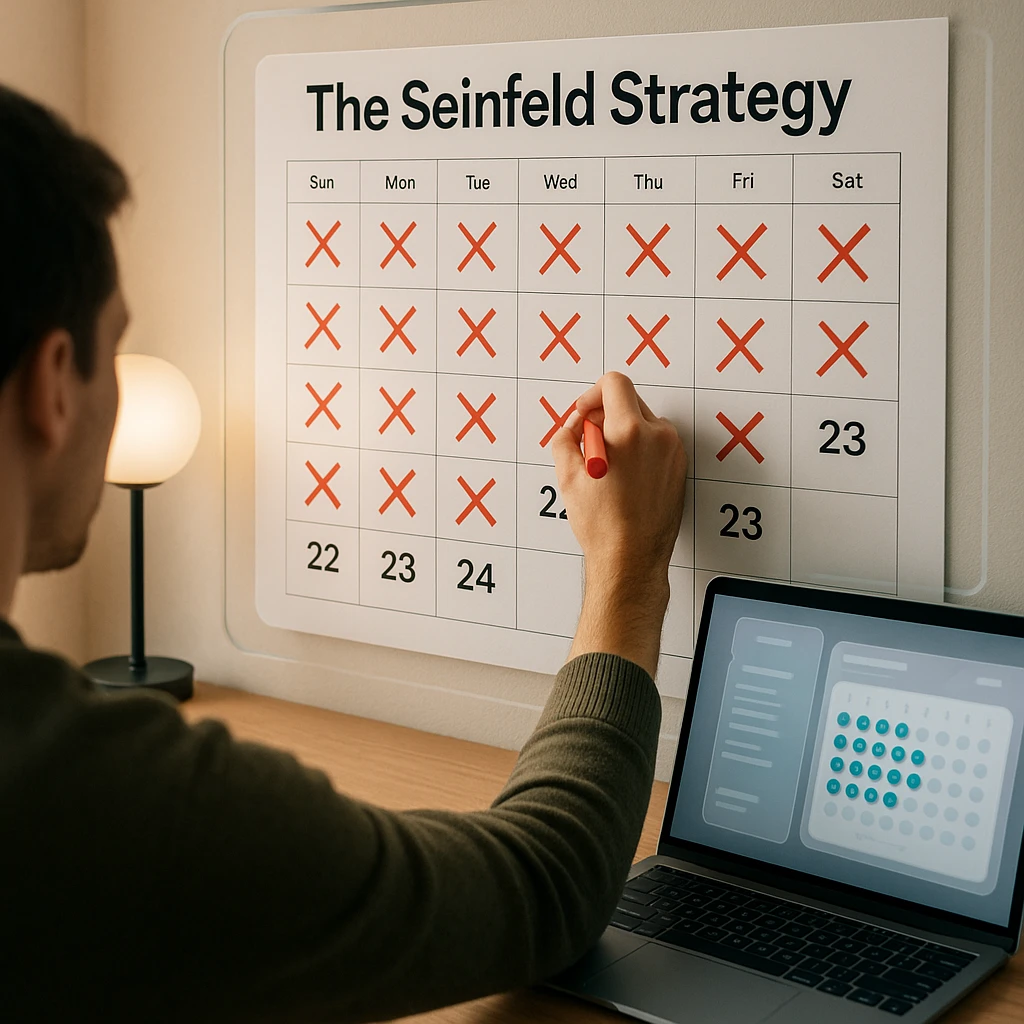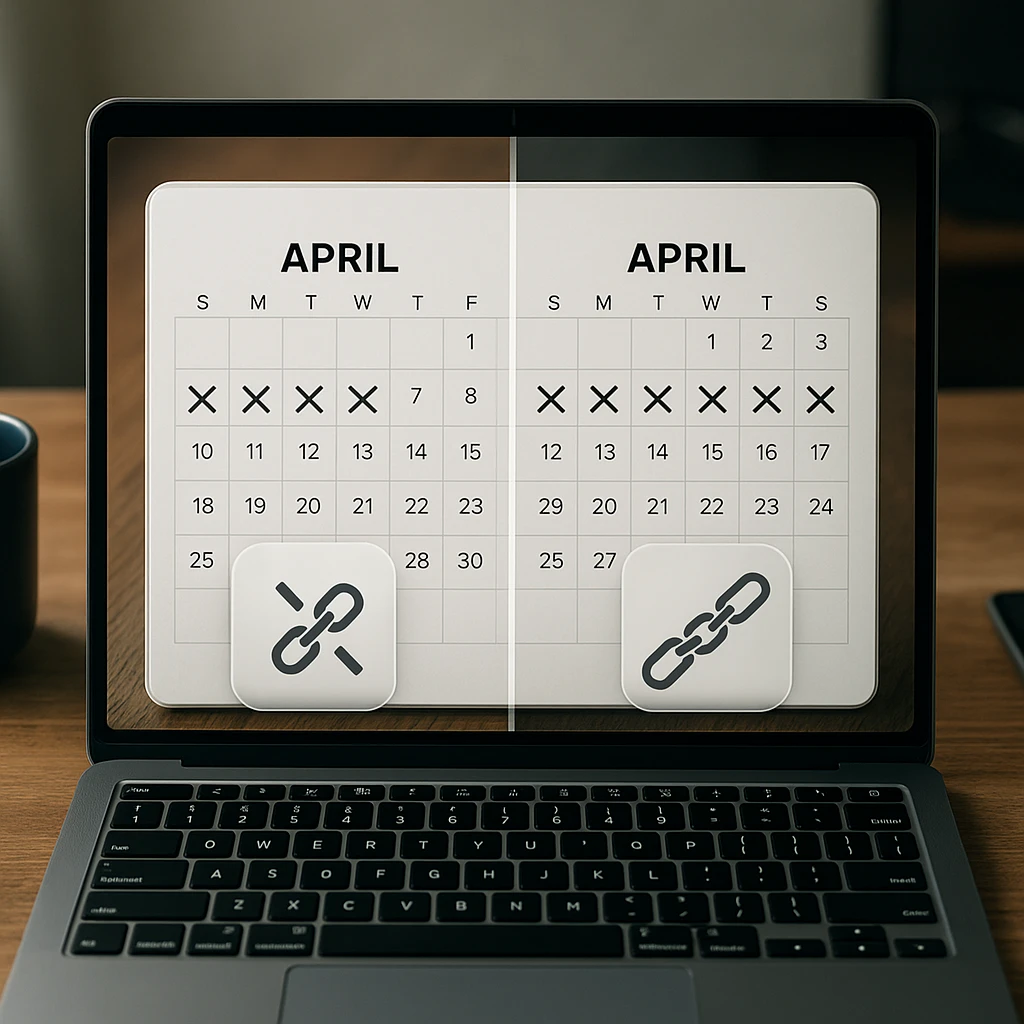The Seinfeld Strategy is one of the simplest yet most powerful productivity methods ever created. Also known as the “don’t break the chain” technique, this approach helped Jerry Seinfeld become one of the most successful comedians in history and it can transform your daily habits too.
Unlike complex productivity systems that require extensive setup, the Seinfeld method uses just a calendar and a red marker to build unstoppable momentum toward your goals. Here’s everything you need to know about implementing this game-changing strategy.

What is the Seinfeld Strategy?
The Seinfeld Strategy is a habit-building technique that focuses on consistency over intensity. What is the Seinfeld strategy exactly? It’s a visual tracking system where you mark an X on a calendar every day you complete a specific task, creating a chain of X’s that you’re motivated not to break.
The method originated from advice Jerry Seinfeld reportedly gave to a young comedian: to become a better comedian, write jokes every day. Get a big wall calendar, mark an X for each day you write, and after a few days, you’ll have a chain. Your only job is to not break the chain.

The core principles of the Seinfeld method center around daily action over perfection, where small and consistent efforts compound over time. Visual motivation plays a crucial role as seeing your progress chain builds unstoppable momentum. The beauty lies in its simplicity since no complex tracking or elaborate systems are required. Most importantly, this approach offers complete flexibility and works for any habit or skill you want to develop.
The beauty of the Seinfeld strategy lies in its psychological power. Once you see a growing chain of successful days, breaking it feels like a genuine loss, creating powerful motivation to continue.
How the Seinfeld Method Works
The Seinfeld method transforms habit formation from a willpower battle into a visual game. Instead of relying on motivation or complex reward systems, you simply focus on not breaking your chain of consecutive days.
The Psychology Behind the Chain
The strategy leverages several powerful psychological principles:
Loss Aversion: People feel the pain of losing something more intensely than the pleasure of gaining it. Once you have a 10-day chain, breaking it feels like losing 10 days of progress.
Visual Progress: Seeing your chain grow provides immediate feedback and satisfaction, reinforcing the behavior even when motivation is low.
Minimum Viable Habits: The focus on daily consistency rather than daily perfection makes the habit sustainable long-term.
Momentum Building: Each successful day makes the next day easier, creating positive momentum that becomes self-reinforcing.
Setting Up Your Seinfeld Calendar
Creating your Seinfeld calendar requires minimal setup but strategic thinking about your target habit.
Choose Your Habit Carefully The most successful Seinfeld Strategy implementations focus on one primary habit that directly impacts your main goal. Jerry Seinfeld chose “write jokes daily” because it directly improved his comedy skills.
Here are examples of effective Seinfeld Strategy habits across different areas:
| Goal Area | Daily Habit | Time Commitment | Why It Works |
|---|---|---|---|
| Writing | Write 200 words | 15-30 minutes | Builds writing muscle memory |
| Fitness | Exercise session | 20 minutes | Creates consistent movement routine |
| Learning | Study new material | 30 minutes | Compounds knowledge over time |
| Business | Make sales calls | 5 calls (15 minutes) | Builds pipeline consistently |
| Creative | Practice instrument | 15 minutes | Develops muscle memory and skills |
Your Seinfeld calendar should be large, visible, and easily accessible. The most effective setups include large wall calendars in prominent locations where you’ll see them multiple times daily. Digital calendar apps with visual tracking work well for people who are always on their phones. Printed monthly calendars with space for large X marks offer the satisfying tactile experience of physically marking your progress. Habit tracking apps that show chain visualization combine the best of both worlds with portability and visual appeal.

Implementing Jerry Seinfeld’s “Don’t Break the Chain” Method
Jerry Seinfeld don’t break the chain isn’t just a catchy phrase but rather a complete methodology for building lasting habits. Here’s how to implement it effectively:
Step 1: Define Your Daily Minimum
The key to Seinfeld don’t break the chain success is setting a daily minimum that’s almost impossible to skip. This should be small enough to do on your worst days but meaningful enough to create real progress.
Finding the right daily minimum requires careful balance. Setting targets that are too big, like “Write 2000 words daily,” becomes unsustainable and leads to chain breaks. The sweet spot involves manageable but meaningful goals like “Write 200 words daily” that you can accomplish even on difficult days while still making real progress. Avoid targets that are too small, such as “Open my writing app daily,” because they lack the impact needed to drive meaningful change.
| Daily Minimum Size | Example | Sustainability | Impact Level |
|---|---|---|---|
| Too Big | Write 2000 words daily | Low (leads to burnout) | High but unsustainable |
| Just Right | Write 200 words daily | High (doable on bad days) | Meaningful and consistent |
| Too Small | Open writing app daily | High but pointless | Very low impact |
Step 2: Choose Your Chain Tracking Method
While Jerry Seinfeld used a physical wall calendar, modern implementations can be digital or physical based on your preferences.
Physical calendars offer the advantage of being always visible as a constant reminder, plus there’s something deeply satisfying about the physical act of marking X’s with a red marker. They have no app dependencies or digital distractions and work particularly well in household or office environments where others can see your progress.
Digital tracking provides accessibility anywhere on your phone, along with automatic reminders and notifications that help maintain consistency. These systems offer data backup and synchronization across devices, plus integration with other productivity tools you might already be using.
| Tracking Method | Best For | Key Advantages | Potential Drawbacks |
|---|---|---|---|
| Physical Calendar | Home/office users | Always visible, tactile satisfaction | Not portable, can be lost |
| Digital Apps | Mobile professionals | Portable, automated reminders | Screen dependency, distractions |
| Hybrid Approach | Flexible lifestyles | Best of both worlds | Requires maintaining two systems |
For content creators and professionals who work with video or audio content, tools like ScreenApp’s AI Note Taker can help track daily learning or content creation habits by automatically capturing key insights from educational videos or meetings, making it easier to maintain consistent learning chains.
Step 3: Start Your Chain
Begin your Seinfeld calendar on any day since there’s no need to wait for Monday or the first of the month. The sooner you start, the sooner you build momentum.
During your first week, focus exclusively on completing the minimum daily requirement without worrying about quality or results. This initial period is about building the habit muscle, not achieving perfection. Celebrate each X as a genuine victory because consistency at this stage matters more than performance. Make sure to place your calendar where you’ll see it multiple times daily, as visual reminders significantly increase your success rate.
Step 4: Protect Your Chain
As your chain grows, it becomes increasingly valuable. The Seinfeld method works because breaking a 20-day chain feels much worse than skipping day one.
Protecting your growing chain requires proactive planning for obstacles like travel, illness, or unusually busy periods. Develop backup plans for difficult days that allow you to maintain your chain even when circumstances aren’t ideal. Remember that some progress is always better than no progress, so be willing to do the absolute minimum rather than break your chain. Most importantly, focus on the habit itself rather than the outcome, as the daily action is what builds long-term success.
Advanced Seinfeld Strategy Techniques
Multiple Chain Management
While beginners should start with one chain, experienced practitioners can manage multiple habits using variations of the Seinfeld strategy.
Managing multiple chains requires strategic thinking about how habits interact and support each other. The sequential approach involves mastering one habit for 66 days before adding another, ensuring solid foundation before expansion. Complementary habits work well together because they reinforce each other, like pairing exercise with meditation for overall wellness. Time-based approaches assign different habits to different parts of the day, such as morning writing and evening reading. Weekly rotation systems focus on different habits each day of the week, providing variety while maintaining structure.
| Multi-Chain Approach | How It Works | Best For | Success Rate |
|---|---|---|---|
| Sequential | Master one habit for 66 days first | Beginners, focused goals | Highest (90%+) |
| Complementary | Habits that support each other | Wellness, skill building | High (75-85%) |
| Time-Based | Different habits at different times | Busy schedules | Medium (60-75%) |
| Weekly Rotation | Different habit each day | Variety seekers | Lower (50-60%) |
Chain Recovery Strategies
Even with the best intentions, chains break. The key is having a recovery strategy that gets you back on track quickly.
When chains inevitably break, your response determines whether you bounce back stronger or give up entirely. Start a new chain immediately rather than waiting for Monday or the beginning of a new month, as delay only makes restarting harder. Take time to analyze what caused the break and create specific prevention strategies for similar situations in the future. Consider whether your daily minimum might be too ambitious and needs adjustment to be more sustainable. Most importantly, remember that a broken chain doesn’t erase the progress you’ve already made or the skills you’ve developed during your streak.
Measuring Chain Success
The Seinfeld method isn’t just about maintaining chains but rather about achieving meaningful progress toward your goals.
Measuring success goes beyond just counting consecutive days. Track your longest unbroken streak to see your peak performance, but also calculate your consistency percentage by dividing completed days by total days attempted. Monitor outcome improvements like skills gained or goals achieved, as these show the real-world impact of your consistency. Pay attention to habit strength by noting how automatic the behavior has become and how much mental effort it requires to complete your daily minimum.
For professionals tracking learning or skill development, ScreenApp’s AI Summarizer can help process daily educational content, making it easier to see tangible progress from your consistent learning chains.

Seinfeld Calendar Templates and Tools
Physical Calendar Options
Wall Calendar Setup:
- Choose calendars with large date squares for clear X marks
- Use bright red markers for maximum visual impact
- Position calendars at eye level in high-traffic areas
- Consider laminated calendars for reusability
DIY Calendar Creation:
- Print monthly calendar templates with enlarged date boxes
- Create custom calendars with your specific habit goals
- Use poster board to create extra-large tracking calendars
- Design calendars with motivational quotes or progress milestones
Digital Seinfeld Strategy Tools
Dedicated Habit Tracking Apps:
- Habitica: Gamifies the chain-building process
- Streaks: Simple, visual chain tracking
- Way of Life: Color-coded habit tracking
- Productive: Clean interface with chain visualization
Calendar App Integration:
- Use recurring events in Google Calendar or Apple Calendar
- Mark completion with specific emojis or symbols
- Set daily reminders for chain maintenance
- Share calendars with accountability partners
Creating Custom Tracking Systems
Spreadsheet Solutions:
- Create monthly grids with conditional formatting
- Use formulas to calculate streak lengths automatically
- Track multiple habits on different sheets
- Generate progress charts and statistics
Notebook Methods:
- Bullet journal habit tracking pages
- Monthly calendar layouts with habit columns
- Weekly review pages for chain analysis
- Progress photos of completed calendar pages
Common Seinfeld Strategy Mistakes to Avoid
Setting Unrealistic Daily Minimums
The biggest mistake in implementing the Seinfeld strategy is choosing daily minimums that are too ambitious. Remember, the goal is consistency, not intensity.
Signs your minimum is too high:
- You frequently struggle to complete it
- You avoid starting because it feels overwhelming
- You complete it some days but skip others regularly
- You feel guilty or stressed about the daily requirement
Focusing on Perfect Chains Only
Jerry Seinfeld calendar success isn’t measured only by perfect, unbroken chains. Real success comes from developing the habit so strongly that it becomes automatic.
Better success metrics:
- Overall consistency percentage over time
- Ability to restart quickly after breaks
- Reduced resistance to doing the daily minimum
- Automatic habit execution without conscious effort
Neglecting the Underlying Goal
The Seinfeld method is a means to an end, not the end itself. Don’t become so focused on maintaining chains that you lose sight of why you started.
Staying goal-focused:
- Regularly review why this habit matters to you
- Celebrate progress toward your larger objectives
- Adjust your daily minimum if it’s not serving your goals
- Connect daily actions to long-term vision
Adapting the Seinfeld Strategy for Different Goals
Creative Pursuits
The Seinfeld strategy originated in comedy writing, making it naturally suited for creative goals.
Creative applications work exceptionally well with the Seinfeld Strategy because creativity benefits from consistent practice. Writers can focus on daily word count minimums to build their writing muscle. Artists benefit from daily sketching or painting practice to develop technique. Musicians see rapid improvement with daily practice sessions, even if just 15 minutes. Photographers can challenge themselves with daily photo exercises to explore new techniques. Designers can maintain creative flow through daily design exercises or challenges.
Professional Development
Seinfeld method applications for career growth focus on skill building and networking. The key is choosing activities that directly advance your professional goals.
| Professional Area | Daily Habit Example | Time Investment | Career Impact |
|---|---|---|---|
| Learning | Complete one course lesson | 30 minutes | Skill advancement |
| Networking | Reach out to one new contact | 10 minutes | Relationship building |
| Skill Practice | Code/design/write daily | 45 minutes | Technical improvement |
| Content Creation | Publish one post/article | 20 minutes | Thought leadership |
| Sales | Make 5 prospecting calls | 30 minutes | Pipeline growth |
For professionals who attend regular meetings or training sessions, ScreenApp’s Meeting Minutes Generator can help maintain learning chains by automatically capturing key insights from daily professional development activities.
Health and Fitness
Physical habits benefit greatly from Seinfeld don’t break the chain consistency.
Health and fitness habits benefit tremendously from the Seinfeld Strategy because small daily actions compound into major lifestyle changes. Exercise habits work well with daily movement minimums that can be as simple as a 10-minute walk. Nutrition improvements come from daily healthy meal preparation or planning, including approaches like healthy weight loss juicing, which supports better energy levels and overall wellness. Sleep quality improves through consistent bedtime routines that signal your body to wind down. Meditation practices build mental resilience through daily mindfulness sessions. Hydration tracking ensures you maintain optimal physical performance throughout the day.
Business and Entrepreneurship
The Seinfeld strategy can drive consistent business growth through daily revenue-generating activities. The key is focusing on activities that directly impact your bottom line or business development.
Business owners see the most success when they focus on daily prospect outreach to build their sales pipeline consistently. Marketing efforts compound through daily content creation that builds audience and authority over time. Product development benefits from daily feature improvements or user feedback analysis. Customer service excellence comes from daily customer check-ins that build loyalty and prevent churn. Industry learning through daily research keeps you ahead of trends and competitive changes.
Measuring Long-Term Success with the Seinfeld Strategy
Tracking Habit Strength
The Seinfeld method ultimately aims to make behaviors automatic. Track how the habit feels over time.
Habit strength develops predictably over time with consistent practice. During weeks 1-2, your new habit requires conscious effort and reminders to complete. By weeks 3-4, the behavior feels more natural but still requires intention and planning. Weeks 5-8 mark the transition point where the habit becomes part of your routine and feels less forced. After week 9 and beyond, the habit feels automatic and natural, requiring minimal mental energy to maintain.
Outcome Measurement
While chain length is important, the real measure of Seinfeld strategy success is progress toward your underlying goals.
Track your progress through multiple methods to get a complete picture of your development. Skill assessments provide regular tests of your developing abilities and show concrete improvement over time. Progress photos offer visual documentation of improvements, particularly useful for fitness, art, or project-based goals. Performance metrics give you quantifiable improvements in your field, such as writing speed, sales numbers, or technical benchmarks. Feedback collection from others provides valuable input about your progress that you might not notice yourself.
Long-Term Habit Evolution
Successful Seinfeld calendar users often find their habits naturally evolve and expand over time.
Successful habits naturally evolve and expand over time without forced effort. Daily minimums often increase organically as your capacity and confidence grow. Related habits begin clustering around your core habits, creating powerful habit stacks that reinforce each other. Quality improvements happen alongside consistency as your skills develop through regular practice. Most importantly, established habits become launching pads for bigger goals, providing the foundation and confidence needed for greater challenges.
Conclusion
The Seinfeld Strategy proves that consistency beats intensity when building lasting habits. By focusing on daily action rather than perfect performance, you can build unstoppable momentum toward any goal.
The most important takeaways for Seinfeld method success center around starting small with daily minimums you can maintain even on difficult days. Keep your chain visible where you’ll see it regularly to maintain motivation. Focus on consistency rather than perfection, as perfect chains aren’t required for success. Protect your chain by planning for obstacles and having recovery strategies ready. Always measure progress by tracking both chain length and advancement toward your underlying goals.
Getting started with your Seinfeld calendar requires just a few simple steps. Choose one specific and measurable daily habit that directly impacts your main goal. Set up your tracking system whether physical or digital based on your preferences. Define your daily minimum clearly so there’s no ambiguity about completion. Start today and don’t wait for the “perfect” time since momentum builds from immediate action. Focus entirely on not breaking the chain rather than perfect performance.
Remember, Jerry Seinfeld don’t break the chain isn’t about perfection but rather about building the kind of consistency that creates lasting change. Whether you’re developing creative skills, professional abilities, or personal habits, the simple act of marking X’s on a calendar can transform your daily actions into remarkable long-term results.
The power of the Seinfeld strategy lies not in its complexity, but in its simplicity. Start your chain today, and discover how small daily actions can create extraordinary outcomes over time.
Frequently Asked Questions
What is the Seinfeld strategy?
The Seinfeld strategy is a habit-building method where you mark an X on a calendar every day you complete a specific task, creating a visual chain that motivates you to maintain consistency. Also known as the “don’t break the chain” method, it focuses on daily action rather than perfect performance.
How does the Seinfeld method work?
The Seinfeld method works by leveraging visual progress and loss aversion psychology. You choose a daily habit, mark X’s on a calendar for each successful day, and focus on not breaking your growing chain. The visual representation of your streak provides motivation and makes skipping feel like a genuine loss.
What should I put on my Seinfeld calendar?
Your Seinfeld calendar should track one primary habit that directly impacts your main goal. Choose something specific and measurable with a daily minimum that’s small enough to do on difficult days but meaningful enough to create progress like “write 200 words” or “exercise 20 minutes.”
How do I set up a Seinfeld calendar?
Setting up a Seinfeld calendar requires a large, visible calendar and a red marker. Choose a wall calendar with big date squares, place it where you’ll see it multiple times daily, and mark a clear X for each successful day. Digital alternatives include habit tracking apps with chain visualization.
What happens if I break my Seinfeld chain?
If you break your Seinfeld don’t break the chain streak, start a new chain immediately without waiting for Monday or a new month. Analyze what caused the break, adjust your daily minimum if needed, and remember that a broken chain doesn’t erase your previous progress or skill development.
Can I track multiple habits with the Seinfeld strategy?
While beginners should start with one habit, experienced users can manage multiple chains using the Seinfeld strategy. Effective approaches include mastering one habit for 66 days before adding another, choosing complementary habits that reinforce each other, or using different habits for different times of day.
How long does it take for the Seinfeld method to work?
The Seinfeld method begins showing psychological benefits within the first week as you see your chain grow. Habit formation typically takes 21-66 days depending on complexity, but the visual motivation and momentum building effects start immediately with your first few X marks.
What’s the difference between the Seinfeld strategy and other habit tracking?
The Seinfeld strategy differs from other habit tracking by focusing specifically on chain visualization and the “don’t break the chain” psychology. Unlike complex point systems or multiple metrics, it uses simple binary tracking (did it or didn’t) with powerful visual motivation through consecutive day streaks.
Should I use a physical or digital Seinfeld calendar?
Both physical and digital Seinfeld calendars can be effective. Physical calendars provide constant visibility and satisfying tactile feedback, while digital options offer portability, reminders, and data backup. Choose based on your lifestyle since office workers often prefer physical, while mobile professionals prefer digital.
How do I choose the right daily minimum for my Seinfeld strategy?
Choose a daily minimum for your Seinfeld strategy that you can complete even on your worst days while still making meaningful progress. It should be specific, measurable, and directly related to your goal. Start smaller than you think you need since you can always do more, but the chain breaks if you do less.



